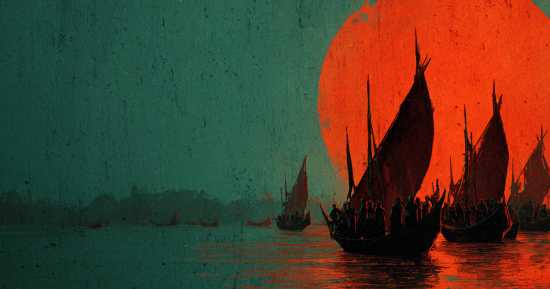
Bursting with color and tradition, the Bangladeshi History Quiz uncovers a land where every celebration, craft, and melody reflects deep cultural pride. Dhaka’s bustling streets hum with the sounds of rickshaw bells and vibrant markets. Villages echo with the laughter of community gatherings, while artisans shape their heritage into handmade crafts. From lush green paddy fields to the mighty rivers, Bangladesh weaves history into daily life. Each festival paints the land with music, food, and shared joy. This living culture thrives in every corner, creating a heritage that feels both rooted and alive.
Across Bangladesh, tradition is expressed through its people. Poets recite verses that speak of nature, family, and resilience. Folk dancers move with unmatched energy during rural fairs, turning ordinary fields into open-air stages. Culinary treasures like hilsa fish curry and pitha sweets bring families together at every occasion. Craftsmanship, from jamdani weaving to pottery, showcases timeless skill passed down through generations. Every aspect of life carries echoes of history, binding communities through shared customs and pride.
The Bangladeshi History Quiz reflects a nation where art and tradition merge with everyday life. Language festivals celebrate Bengali literature and its power to unite. Boat races bring riverside towns to life with thrilling competition and cheering crowds. Family kitchens preserve recipes that have nourished generations. Through these customs, Bangladesh preserves its vibrant past while embracing a dynamic future.
7 Serious Facts About Bangladeshi History Quiz
- Bengali New Year dates back hundreds of years and remains a major cultural event.
- Bangladesh has a thriving craft industry centered on weaving and pottery.
- Folk music is a critical tool for preserving oral history.
- Art and literature festivals attract international scholars and artists.
- Hilsa fish holds both cultural and economic importance in Bangladesh.
- Government programs actively support cultural preservation in rural communities.
- Educational initiatives teach younger generations traditional arts and music.
Festivals and Cultural Traditions
Pohela Boishakh, the Bengali New Year, transforms the country into a tapestry of music, dance, and colorful processions. Markets overflow with handcrafted goods and traditional sweets. Musicians perform folk songs that echo through city streets and village squares. Every detail celebrates renewal and community. It is a day where cultural pride shines brightly.
Rural fairs also highlight Bangladesh’s deep cultural roots. Pottery stalls, weaving displays, and local theater performances bring tradition to life for younger generations. Villagers gather to share meals and stories, reinforcing bonds between neighbors. Every fair feels like a step back into history. These gatherings ensure that heritage thrives in the modern era.
Language and literature festivals add intellectual richness. Poets, writers, and performers gather to share work inspired by history and daily life. Traditional art exhibitions accompany these events, showcasing everything from calligraphy to folk paintings. These celebrations connect people not only to their culture but also to each other.
Art, Music, and Culinary Heritage
Bengali art reflects the landscapes and stories of its people. Jamdani weavers craft intricate patterns that represent centuries of mastery. Folk painters create vibrant scenes inspired by rural traditions. Pottery artisans shape clay into objects that serve both function and beauty. These crafts represent Bangladesh’s artistic soul.
Music remains a powerful cultural thread. Baul singers share soulful melodies that explore love, philosophy, and joy. Drums and flutes accompany village celebrations, filling the air with infectious rhythms. Classical performances in urban centers highlight Bangladesh’s refined musical heritage. Together, these sounds weave a powerful cultural soundtrack.
Cuisine binds people to their history. Fragrant rice dishes, spiced curries, and delicate sweets define family tables. Hilsa fish holds special symbolic value, especially during festivals. Street vendors offer puchka and jhalmuri, delighting locals and visitors alike. Food in Bangladesh remains a living connection to heritage.
Community Spirit and Living Heritage
Community life in Bangladesh thrives through cooperation and shared tradition. Villages hold cultural nights where music and storytelling keep history alive. Urban neighborhoods organize art fairs and craft markets. These gatherings showcase local creativity while strengthening unity. Heritage is not merely observed—it is actively lived.
Generational knowledge plays a central role. Elders teach crafts like weaving and pottery to younger family members. Folk songs are passed down orally, preserving their meaning across centuries. Through this exchange, culture stays vibrant and relevant. Every generation adds its voice to Bangladesh’s story.
Modern cultural programs also help traditions flourish. Schools integrate folk arts into their lessons. Government initiatives support cultural festivals nationwide. These efforts ensure that Bangladesh’s heritage continues to grow while remaining true to its roots.
7 Fun Facts About Bangladeshi History Quiz
- Pohela Boishakh is celebrated with colorful street parades and traditional music across the country.
- Jamdani weaving is recognized by UNESCO as an intangible cultural heritage.
- Boat racing festivals bring entire riverside communities together.
- Street food like fuchka and chotpoti is an essential part of Bangladeshi culture.
- Traditional Baul songs are both music and spiritual poetry.
- Folk art often features motifs inspired by nature and rural life.
- Language festivals honor the legacy of Bengali literature and arts.
Bangladeshi History – FAQ
The geographical features of Bangladesh, including its deltaic landscape and vulnerability to natural disasters, have significantly impacted the country’s historical trajectory. The fertile land and river systems have shaped the agrarian economy and cultural practices of the region. Additionally, factors such as flooding and cyclones have posed challenges to governance and development efforts in Bangladesh throughout history.
